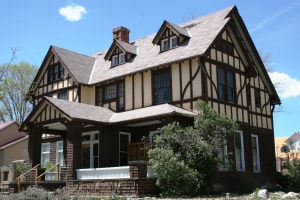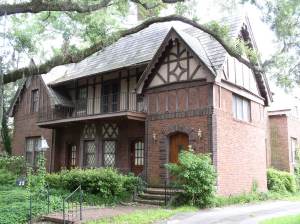Tudor Revival

Las Vegas, NM. A fine example of ornamental half-timbering, steeply pitched roofs, and asymmetrical floor plan.
PERIOD OF POPULARITY: Roughly 1910 – 1940 (mostly 1920s prior to the Great Depression).
INTRODUCTION TO REVIVAL STYLES: Each revival style identifies specifically with an architecture of an earlier time and place, especially those related to early American or European precedents. Several popular revival styles are included on this blog, though other, less popular revival styles also appeared. To classify this grouping of architectural styles presents a challenge, as one could argue that many earlier Victorian styles were similarly revivalist. In fact, one publication includes several revival styles within the larger category of Victorian architecture (Cunliffe, et. al. 2010). The concept of “period styles” has also been adopted by some writers (including this one), though it was an early 20th century term used by non-professionals to romanticize the past. On the flip side are the architectural historians who prefer the more academic “Age of eclecticism” or “Eclectic Era,” which is an important concept to provide historical context here. The Eclectic Era, however, includes both revival and early modern styles that competed ideologically and appeared nearly simultaneously before the Great Depression. For purposes here, then, “revival styles” seems most appropriate, adapted widely across America for use in middle-class homes, wealthy country houses, commercial buildings, early skyscrapers, and civic buildings. Though overlapping with the more picturesque Victorian era, these styles largely gained popularity during the first two decades of the 20th century and heavily influenced our residential and commercial landscapes.
During this time (mostly between 1900 and 1929), accuracy of styles became important once again, unlike Queen Anne style, which borrowed from a variety of sources. Most Important, revival styles look to the past for inspiration. The trend toward revivalist architecture gained momentum from the 1893 Chicago World’s Fair, the Columbian Exposition, where historical interpretations of European styles were encouraged. Simultaneous to the rise of revivalist architecture, the modern era saw its beginnings with architects who were instead looking to the future, not to the past, with more progressive, modernist styles. Thus defines the Eclectic Movement of the early 20th century, which consisted of a simultaneous and perhaps competing interest in both modern and historic architectural traditions. This variety, or eclecticism, provided for one of the most diverse and colorful periods for architecture and urban design in American history, when almost anyone with at least a middle-class income could choose from one of a dozen or more styles for their home.
HISTORICAL BACKGROUND AND FEATURES: Tudor revival became especially popular for 1920s suburban homes, loosely based on late medieval prototypes. The style reaches back to England’s Tudor period (1500-1559) as a romanticized revival of the timber-frame buildings popular at that time. Many of the revival examples are dominated visually with (ornamental) half-timbering, a medieval English building tradition, often with stucco or masonry veneered walls, steeply pitched roof, and cross-gabled plans. A varient of this is sometimes referred to as the Picturesque Cottage or English Cottage, which typically includes a picturesque (asymmetrical) floor plan but without the half timbering. A whimsical variant of the Tudor Revival is the playful Storybook Style, also known as the Cotswold Cottage or Hansel and Gretel Cottage. The Cotswald cottage imitates late medieval structures characteristic to England’s Cotswald region. Even more based in fantasy and Disney-esque imagery are the Storybook Style homes that appeared during the early 20th century, primarily in wealthier areas.
For More Photos of Tudor Revival on Flickr, Click Here.

Venice Beach, CA. This L.A. beach community includes several examples of the Storybook Style, a playful variation of the English Tudor cottage.

Flagstaff, AZ. c.1926. The Santa Fe Railway Depot in Tudor Revival style: half-timbering, diamond-paned casement windows, decorative chimneys, steeply pitched roof with dormers.

Savannah, GA. This design includes various references to English medieval architecture, including half-timbering and diamond-paned casement windows.

Long Beach, CA. This Tudor Revival mansion pulls out all the stops, even without the half-timbered facade.


Comments
2 Responses to “Tudor Revival”Trackbacks
Check out what others are saying...[…] Architecture Styles […]
[…] Gingerbread House is a Tudor Revival style house built in 1926. It’s just under 1,000 square feet and has 2 bedrooms and a small […]